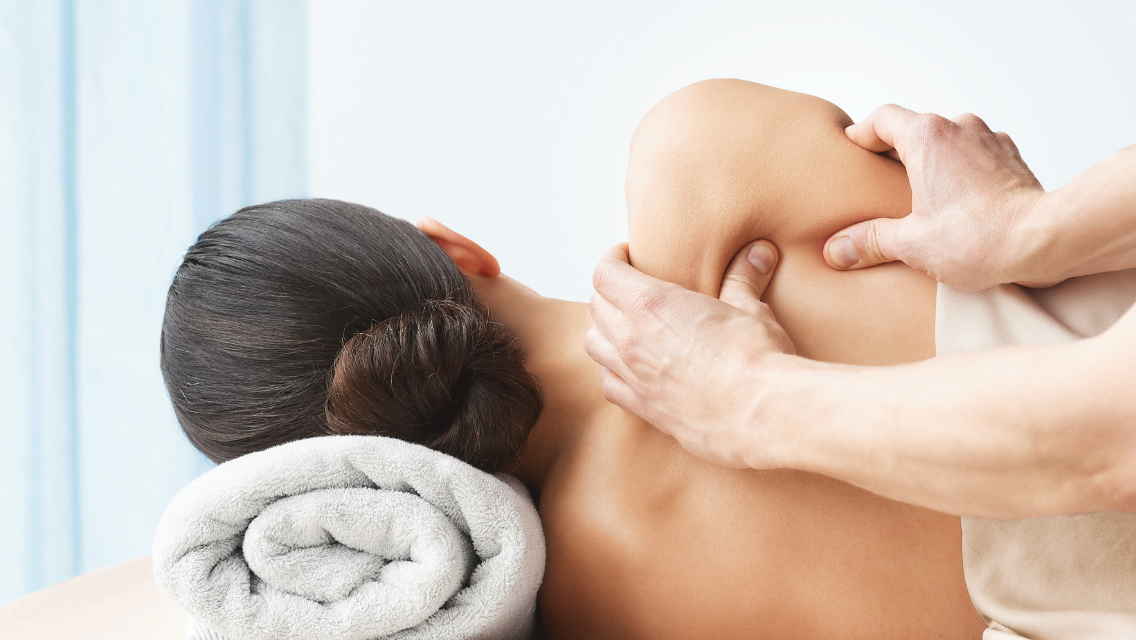You may be chalking it up to age or the vestiges of an old injury. And you may be partly right. But when your running stride feels clunky, or when you’re greeted by a lower-back ache every morning and you can’t fathom touching your toes, it could be more than mere wear and tear. You may be suffering from myofascial restriction.
Most active adults are probably familiar with the symptoms of myofascial restriction, even if they don’t know the syndrome by name. It can show up as a dull, chronic ache in a knee joint, a shortened range of motion on a tennis backhand, or muscles that tighten as you sleep. Such stiff, achy, creaky conditions do tend to get worse with age, but most myofascial-release experts see an underlying culprit in restricted fascia – the weblike connective tissue that surrounds and holds the shape of all the soft tissues in the body, including muscles (the “myo” part of the term “myofascial”).
To understand fascia and how it works, think of an orange. Under the orange peel is the pith, the white fiber netting. Beyond the pith is the membrane that gives orange slices their shape, and even deeper is a thinner membrane that forms the tiny individual pulp. All of this internal material – the netting and the membranes – is much like the fascia in the human body.
In its healthiest state, fascia is elastic and flexible, providing lubrication between structures, allowing muscles to glide freely, and even contributing to metabolic processes and neural function. But when the fascia tightens or becomes restricted in its range of motion, muscles also become shortened and restricted. Movement is impeded, posture is compromised, and the many systems fascia supports start to falter.
Lack of use or habitually limited range of motion can contribute to fascia tightening. But so can rough handling: “Any kind of trauma – an accident, a fall or some kind of overuse injury, as well as the inflammation reaction that occurs afterward – can cause the fascia to become restricted. It tightens down and shortens,” explains Cathy Covell, a physical therapist with the Myofascial Release Treatment Center in Paoli, Penn. And when fascia becomes restricted, it tends to impede the function of underlying muscle and nerves – in effect, by squishing them.
Bad posture can also lead to fascia problems. “If you sit at a computer for a long time, for example, the tissues at the front of the shoulders and hips are going to tighten, because the body wants to make it easier to stay in that position. Over time, you’ll stoop forward,” Covell says. As shortened muscles and fascia grow more stiff, they can eventually unleash a cascade of other problems as the body tries to compensate for the resulting imbalance. Headaches, muscle tightness and more mysterious pains may all trace their roots to myofascial restriction.
Trigger Points
In your muscles, myofascial restrictions feel like knots within ropey bands of dense material.
This knotty, shortened tissue, deep in the muscle fiber, is also home to devilish, tiny adhesions known as trigger points, so named because they “trigger” pain reactions (e.g., burning, numbness, cramping) that often reach, or refer, beyond the immediate site, explains Hal Blatman, MD, president of the American Holistic Medical Association and coauthor of The Art of Body Maintenance: Winners’ Guide to Pain Relief.
Trigger points cause most of your body’s pain and virtually all myofascial (soft-tissue) pain, says Blatman.
For example, trigger points in the suboccipital muscles – the four small muscles at the back of the head that connect to the top of the spine – can cause migraine-headache symptoms. “If you have a migraine, you have myofascial pain, but most doctors don’t call it that,” he says. “If you have plantar fasciitis, you have myofascial pain. If you are diagnosed with arthritis, some of it’s likely to be myofascial pain, as well. Myofascial pain is part of almost any kind of pain pattern.”
How to Release Muscle Knots
There are several methods of providing relief. Some myofascial therapists use a combination of hands-on techniques to warm and stretch the fascia before locating trigger points and using deep strokes to release the contraction and invite circulation into the area. They also identify activities that exacerbate your pain and recommend ways to avoid retriggering problems.
Other techniques focus more exclusively on releasing trigger points, or combine release methods with lifestyle and nutritional advice designed to facilitate healing; still others combine trigger-point release with stretching.
Some techniques, such as Rolfing or structural integration, analyze a person’s posture to assess misalignment, and then, using a combination of deep, slow, soft-tissue manipulation techniques, move layer by layer through the tissue, stretching fascia and releasing adhesions and trigger points along the way.
Covell uses a technique called myofascial release, which utilizes gentle stretching and sustained pressure (with a minimum of a minute and a half to two minutes per area) until the body releases the restriction on its own, deep in its collagenous layer. Collagen is like plastic – once you stretch it beyond a certain point, it will maintain the new length. With this technique, the body may spontaneously move as the restriction releases, something practitioners call “unwinding.”
Blatman says there are some key myofascial techniques you can do on your own that are just as crucial as help from the pros.
Self-myofascial release requires a tool, such as a tennis ball, to reach trigger points and break through restrictions. Manufacturers have created numerous devices – including foam rollers and knob-ended handheld massagers – to allow people to work on their own myofascial issues. The key to self-care, says Blatman, is learning where your trigger points are and using the tools regularly, followed by stretching, to keep pain at bay.
“Stretching the fascia is the cure for myofascial pain,” he says. “Myofascial release, trigger-point therapy, massage therapy, acupressure – they’re all ways to allow that to happen. Once you work out restrictions, you’ll be stronger, your endurance will be greater, and your pain is going to decrease. Plus, your flexibility is going to be improved, so your chance for future injury will be less.”
Relief Through Release
Here are some indications that your pain might be caused by restricted fascia and improved through myofascial release techniques:
- You feel a dull, hot, aching pain in your muscles or suffer from chronic joint or muscle stiffness.
- You feel clumsy, weak or uncoordinated, like your muscles are no longer following orders.
- You notice your range of motion has become more limited.
- You feel like you have a pinched nerve, or you continue to experience muscle cramps from a previously torn muscle.
- You have intermittent tingling or numbness in an arm or leg.
- You feel cramping or burning pain in an area of your body.
This article has been updated and originally appeared as “Deep Release” in the July/August 2007 issue of Experience Life.






This Post Has 0 Comments